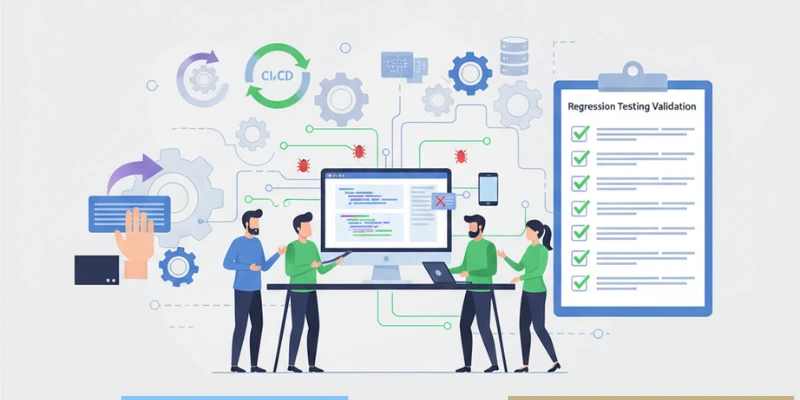In the fast-paced world of software development, one small change in code can ripple through an entire system, sometimes breaking features that once worked perfectly. This is where regression testing comes into play; it ensures that new updates or bug fixes don’t compromise existing functionality. For learners and professionals eager to understand its importance, concepts like regression testing are explored thoroughly in Software Testing Classes in Pune at FITA Academy, where the focus is on building strong fundamentals that align with real-world practices.
Understanding Regression Testing in Simple Terms
Regression testing is the practice of retesting software to ensure that functionalities remain functional after any modifications. Whenever developers fix bugs, introduce enhancements, or add new functionality, there’s always a chance that the change unintentionally affects older modules. Regression testing acts as a safeguard, verifying that the system’s integrity remains intact.
Imagine the scenario where an e-commerce platform updates its payment gateway to support a new method. While the change may seem small, it could potentially impact older payment options, cart calculations, or order history displays. Regression testing ensures such risks are addressed before users encounter them. At its core, regression testing is about preserving quality and protecting user trust. Without it, companies may deliver updates faster, but the cost of introducing errors into production could be catastrophic ranging from revenue loss to damaged reputation.
Why Regression Testing is a Backbone of Software Quality
Every release cycle in modern software development includes multiple changes. New features, bug fixes, and patches are part of daily operations, especially in agile environments. With so many modifications, regression testing becomes essential to confirm stability.
One of the biggest reasons regression testing is crucial is its ability to detect unintended side effects. Developers may focus on specific modules when coding, but applications are interconnected. A single change in the database layer, for example, could cause failures in reporting dashboards or user interfaces. By systematically re-running test cases across all relevant areas, teams can uncover such issues early. Furthermore, regression testing supports continuous integration and delivery practices. In DevOps pipelines, automated regression test suites are triggered after every commit, providing immediate feedback on the health of the build. This not only reduces risk but also accelerates delivery by ensuring confidence in each.
How Regression Testing Differs from Other Testing Types
Many beginners confuse regression testing with other testing activities, but it has unique characteristics. Regression testing examines the system as a whole following changes, as opposed to unit testing, which concentrates on specific features or modules. It also differs from functional testing, which validates new features specifically.
For example, if a new search filter is added to a website, functional testing ensures that the filter works correctly. Regression testing, on the other hand, confirms that older filters like “sort by price” or “sort by rating” still function properly after the update. This holistic approach ensures nothing breaks during the transition from one release to the next. Regression testing is not a one-time effort. It must be performed regularly because every new update, no matter how small, carries the risk of breaking something else. To understand how regression fits within broader testing practices, check out How Agile Testing Is Reshaping Modern Software Development.
Manual vs Automated Regression Testing
One common question in testing teams is whether regression testing should be manual or automated. The answer depends on factors like project size, budget, and frequency of releases. Manual regression testing is useful for smaller projects where changes are infrequent. Testers manually execute old test cases to verify system behavior. This approach is time-consuming and prone to human error, despite its effectiveness.
Automated regression testing, on the other hand, leverages tools and frameworks to re-run large sets of test cases quickly. Once automation scripts are written, they can be reused for every release, significantly reducing effort. For projects that adopt agile or DevOps methodologies, automation is the go-to approach because it supports faster feedback cycles and continuous testing. In most real-world environments, a hybrid approach is followed: critical scenarios are automated, while exploratory or less frequent checks are performed manually.
Choosing the Right Test Cases for Regression Testing
Not all test cases need to be re-executed during regression testing. Selecting the right ones is vital for saving time and ensuring coverage. Typically, test cases are chosen based on areas most likely to be affected by recent changes. High-priority features such as login, checkout, or data processing modules usually form part of regression suites because their failure would have severe consequences. Similarly, test cases covering bug fixes are always included, as these are the areas most directly modified.
Over time, regression test suites tend to grow large. To manage them effectively, testers prioritize based on business impact, criticality, and frequency of use. This balance ensures that resources are spent wisely while still maintaining confidence in the system, a concept often emphasized in Software Testing Courses in Hyderabad, where learners are taught how to design efficient regression strategies for real-world projects.
Benefits of Regression Testing in Real Projects
The importance of regression testing becomes clear when applied to real-world scenarios. Consider a healthcare system where new modules are frequently added, such as patient portals or billing updates. A bug in one area could potentially affect sensitive patient data if left unchecked. Regression testing helps maintain compliance with strict industry standards while ensuring safety.
In the financial sector, applications deal with real-time transactions and sensitive information. Even minor issues could result in significant monetary losses. Regression testing provides the stability needed for secure and reliable operations. By integrating regression testing into release cycles, businesses not only improve quality but also gain user confidence. Customers expect applications to function consistently; regression testing helps meet that expectation with every update.
Common Challenges in Regression Testing
While regression testing is vital, it also comes with challenges. One major issue is the growing size of test suites over time. As software evolves, the number of scenarios to be retested expands, increasing execution time and maintenance. Another challenge lies in deciding which test cases to automate. Automation requires initial investment in terms of effort, tools, and skill. Frameworks give teams the ability to manage complicated projects and interact easily with DevOps pipelines by providing a standard approach.
Additionally, fast-paced release cycles sometimes pressure teams to cut corners, skipping thorough regression testing. While this may save time in the short term, it increases long-term risks by potentially introducing defects into production. Overcoming these challenges requires planning, prioritization, and the smart use of automation frameworks. Many testers who undergo structured learning paths, Software Testing Training in Kolkata gain the skills needed to handle these complexities effectively.
Regression Testing in Agile and DevOps Environments
With a rise of agile and DevOps methodologies, regression testing has evolved significantly. In traditional waterfall models, regression was performed only at the end of development. However, in agile, where sprints introduce new features every few weeks, regression testing happens continuously.
Automated regression suites are integrated into CI/CD pipelines, ensuring immediate validation of every build. This rapid feedback loop allows teams to fix issues quickly before they escalate. In DevOps, the goal is to deliver updates faster without sacrificing quality, and regression testing is a key enabler of that vision. Teams working in these environments also practice shift-left testing, where regression checks begin early in the development cycle. By doing so, they detect issues sooner and reduce the cost of fixing them later.
Best Practices for Effective Regression Testing
To maximize the effectiveness of regression testing, teams often adopt best practices that balance thoroughness with efficiency. Some of these include maintaining a lean regression suite by regularly reviewing and removing redundant cases, updating test cases alongside code changes, and leveraging automation wherever possible.
It’s also important to document regression testing outcomes clearly. Detailed reports provide stakeholders with visibility into system stability, helping them make informed decisions about releases. Collaboration is another cornerstone of success. Developers, testers, and business analysts should work together to identify potential impact areas for regression testing. By aligning technical and business perspectives, teams ensure that testing covers both functional correctness and user expectations.
The Future of Regression Testing
As technology advances, regression testing will continue to evolve. Artificial intelligence(AI) and machine learning(ML) are already being explored to optimize test case selection, predict high-risk areas, and reduce execution time. These innovations will make regression testing smarter and more adaptive, keeping pace with the demands of modern software development. In the future, we can expect regression testing to integrate even more deeply with continuous delivery pipelines, providing real-time assurance of software quality. Organizations that embrace these advancements will not only deliver faster but also build stronger trust with their users.
Regression testing is not just a technical activity; it is a business necessity. By ensuring that new changes do not disrupt existing functionality, it protects both product quality and user trust. From e-commerce platforms to banking systems, every industry relies on regression testing to maintain stability across updates. For learners and professionals looking to master this essential practice, through Software Testing Courses in Kochi can provide the skills and confidence needed to handle real-world testing challenges. Ultimately, regression testing guarantees that every release is both innovative and reliable, striking the perfect balance between speed and quality.
Also Check: ISTQB Certification Explained: Meaning & Advantages


